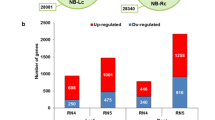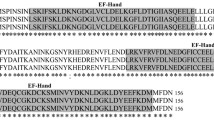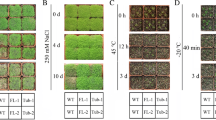Abstract
Stress-associated proteins (SAPs), such as A20/AN1 zinc-finger domain-containing proteins, have emerged as a novel class of proteins involved in abiotic stress signaling, and they are important candidates for preventing the loss of yield caused by exposure to environmental stresses. In a previous report, it was found that the ectopic-expression of Lobularia maritima stress-associated protein, LmSAP, conferred tolerance to abiotic and heavy metal stresses in transgenic tobacco plants. This study aimed to investigate the functions of the A20 and AN1 domains of LmSAP in salt and osmotic stress tolerance. To this end, in addition to the full-length LmSAP gene, we have generated three LmSAP-truncated forms (LmSAPΔA20, LmSAPΔAN1, and LmSAPΔA20-ΔAN1). Heterologous expression in Saccharomyces cerevisiae of different truncated forms of LmSAP revealed that the A20 domain is essential to increase cell tolerance to salt, ionic, and osmotic stresses. Transgenic tobacco plants overexpressing LmSAP and LmSAPΔAN1 constructs exhibited higher tolerance to salt and osmotic stresses in comparison to the non-transgenic plants (NT) and lines transformed with LmSAPΔA20 and LmSAPΔA20-ΔAN1 constructs. Similarly, transgenic plants overexpressing the full-length LmSAP gene and LmSAPΔAN1 truncated domain maintained higher superoxide dismutase (SOD), catalase (CAT), and peroxidase (POD) enzymatic activities due to the high expression levels of the genes encoding these key antioxidant enzymes, MnSOD, POD, and CAT1, as well as accumulated lower levels of malondialdehyde (MDA) under salt and osmotic stresses compared to NT and LmSAPΔA20 and LmSAPΔA20-ΔAN1 forms. These findings provide insights into the pivotal role of A20 and AN1 domains of LmSAP protein in salt and osmotic stress tolerance.






Similar content being viewed by others
References
Aebi H (1984) Catalase in vitro. In: Methods Enzymol., vol 105. Elsevier, pp 121–126
Atanassov II, Atanassov II, Etchells JP, Turner SR (2009) A simple, flexible and efficient PCR-fusion/gateway cloning procedure for gene fusion, site-directed mutagenesis, short sequence insertion and domain deletions and swaps. Plant Methods 5(1):14
Ben Saad R, Zouari N, Ben Ramdhan W, Azaza J, Meynard D, Guiderdoni E, Hassairi A (2010) Improved drought and salt stress tolerance in transgenic tobacco overexpressing a novel A20/AN1 zinc-finger “AlSAP” gene isolated from the halophyte grass Aeluropus littoralis. Plant Mol Biol 72(1–2):171–190
Ben Saad R, Fabre D, Mieulet D, Meynard D, Dingkuhn M, Al-Doss A, Guiderdoni E, Hassairi A (2012) Expression of the Aeluropus littoralis AlSAP gene in rice confers broad tolerance to abiotic stresses through maintenance of photosynthesis. Plant Cell Environ 35(3):626–643
Ben Saad R, Farhat-Khemekhem A, Ben Halima N, Ben Hamed K, Brini F, Saibi W (2017) The LmSAP gene isolated from the halotolerant Lobularia maritima improves salt and ionic tolerance in transgenic tobacco lines. Funct Plant Biol 45(3):378–391
Ben Saad R, Hsouna AB, Saibi W, Hamed KB, Brini F, Ghneim-Herrera T (2018) A stress-associated protein, LmSAP, from the halophyte Lobularia maritima provides tolerance to heavy metals in tobacco through increased ROS scavenging and metal detoxification processes. J Plant Physiol 231:234–243
Bradford MM (1976) A rapid and sensitive method for the quantitation of microgram quantities of protein utilizing the principle of protein-dye binding. Anal Biochem 72:248–254
Catrysse L, Vereecke L, Beyaert R, van Loo G (2014) A20 in inflammation and autoimmunity. Trends Immunol 35(1):22–31
Chang EJ, Ha J, Kang SS, Lee ZH, Kim HH (2011) AWP1 binds to tumor necrosis factor receptor-associated factor 2 (TRAF2) and is involved in TRAF2-mediated nuclear factor-kappaB signaling. Int J Biochem Cell Biol 43(11):1612–1620
Chang L, Chang HH, Chang JC, Lu HC, Wang TT, Hsu DW, Tzean Y, Cheng AP, Chiu YS, Yeh HH (2018) Plant A20/AN1 protein serves as the important hub to mediate antiviral immunity. PLoS Pathog 14(9):e1007288
Chen H, Nelson RS, Sherwood JL (1994) Enhanced recovery of transformants of Agrobacterium tumefaciens after freeze-thaw transformation and drug selection. BioTechniques 16 (4):664–668, 670
Dansana PK, Kothari KS, Vij S, Tyagi AK (2014) OsiSAP1 overexpression improves water-deficit stress tolerance in transgenic rice by affecting expression of endogenous stress-related genes. Plant Cell Rep 33(9):1425–1440
Dixit VM, Green S, Sarma V, Holzman LB, Wolf FW, O’Rourke K, Ward PA, Prochownik EV, Marks RM (1990) Tumor necrosis factor-alpha induction of novel gene products in human endothelial cells including a macrophage-specific chemotaxin. J Biol Chem 265(5):2973–2978
Dixit A, Tomar P, Vaine E, Abdullah H, Hazen S, Dhankher OP (2018) A stress-associated protein, AtSAP13, from Arabidopsis thaliana provides tolerance to multiple abiotic stresses. Plant Cell Environ 41(5):1171–1185
Dong QL, Duan DY, Zhao S, Xu BY, Luo JW, Wang Q, Huang D, Liu CH, Li C, Gong XQ, Mao K, Ma FW (2018) Genome-wide analysis and cloning of the apple stress-associated protein gene family reveals MdSAP15, which confers tolerance to drought and osmotic stresses in transgenic Arabidopsis. Int J Mol Sci 19(9):2478
Draper HH, Squires EJ, Mahmoodi H, Wu J, Agarwal S, Hadley M (1993) A comparative evaluation of thiobarbituric acid methods for the determination of malondialdehyde in biological materials. Free Radic Biol Med 15(4):353–363
Duan W, Sun BG, Li TW, Tan BJ, Lee MK, Teo TS (2000) Cloning and characterization of AWP1, a novel protein that associates with serine/threonine kinase PRK1 in vivo. Gene 256(1–2):113–121
Elble R (1992) A simple and efficient procedure for transformation of yeasts. BioTechniques 13(1):18–20
Evans PC, Ovaa H, Hamon M, Kilshaw PJ, Hamm S, Bauer S, Ploegh HL, Smith TS (2004) Zinc-finger protein A20, a regulator of inflammation and cell survival, has de-ubiquitinating activity. Biochem J 378 (Pt 3:727–734
Gimeno-Gilles C, Gervais ML, Planchet E, Satour P, Limami AM, Lelievre E (2011) A stress-associated protein containing A20/AN1 zing-finger domains expressed in Medicago truncatula seeds. Plant Physiol Biochem 49(3):303–310
Giri J, Vij S, Dansana PK, Tyagi AK (2011) Rice A20/AN1 zinc-finger containing stress-associated proteins (SAP1/11) and a receptor-like cytoplasmic kinase (OsRLCK253) interact via A20 zinc-finger and confer abiotic stress tolerance in transgenic Arabidopsis plants. New Phytol 191(3):721–732
Giri J, Dansana PK, Kothari KS, Sharma G, Vij S, Tyagi AK (2013) SAPs as novel regulators of abiotic stress response in plants. BioEssays : News Rev Mol, Cell Dev Biol 35(7):639–648
Gururani MA, Mohanta TK, Bae H (2015) Current understanding of the interplay between phytohormones and photosynthesis under environmental stress. Int J Mol Sci 16(8):19055–19085
Hishiya A, Iemura S, Natsume T, Takayama S, Ikeda K, Watanabe K (2006) A novel ubiquitin-binding protein ZNF216 functioning in muscle atrophy. EMBO J 25(3):554–564
Hoekema A, Hirsch PR, Hooykaas PJJ, Schilperoort RA (1983) A binary plant vector strategy based on separation of vir- and T-region of the Agrobacterium tumefaciens Ti-plasmid. Nature 303:179–180
Hozain M, Abdelmageed H, Lee J, Kang M, Fokar M, Allen RD, Holaday AS (2012) Expression of AtSAP5 in cotton up-regulates putative stress-responsive genes and improves the tolerance to rapidly developing water deficit and moderate heat stress. J Plant Physiol 169(13):1261–1270
Huang J, Teng L, Li L, Liu T, Li L, Chen D, Xu LG, Zhai Z, Shu HB (2004) ZNF216 is an A20-like and IkB kinase gamma-interacting inhibitor of NFkB activation. J Biol Chem 279(16):16847–16853
Huang XS, Luo T, Fu XZ, Fan QJ, Liu JH (2011) Cloning and molecular characterization of a mitogen-activated protein kinase gene from Poncirus trifoliata whose ectopic expression confers dehydration/drought tolerance in transgenic tobacco. J Exp Bot 62:5191–5206
Jia HX, Li JB, Zhang J, Ren YQ, Hu JJ, Lu MZ (2016) Genome-wide survey and expression analysis of the stress-associated protein gene family in desert poplar, Populus euphratica. Tree Genet Genomes 12(4):78
Jin Y, Wang M, Fu J, Xuan N, Zhu Y, Lian Y, Jia Z, Zheng J, Wang G (2007) Phylogenetic and expression analysis of ZnF-AN1 genes in plants. Genomics 90(2):265–275
Kang M, Fokar M, Abdelmageed H, Allen RD (2011) Arabidopsis SAP5 functions as a positive regulator of stress responses and exhibits E3 ubiquitin ligase activity. Plant Mol Biol 75(4–5):451–466
Kanneganti V, Gupta AK (2008) Overexpression of OsiSAP8, a member of stress associated protein (SAP) gene family of rice confers tolerance to salt, drought and cold stress in transgenic tobacco and rice. Plant Mol Biol 66(5):445–462
Kothari KS, Dansana PK, Giri J, Tyagi AK (2016) Rice stress associated protein 1 (OsSAP1) interacts with aminotransferase (OsAMTR1) and pathogenesis-related 1a protein (OsSCP) and regulates abiotic stress responses. Front Plant Sci 7:1057
Lee D, Takayama S, Goldberg AL (2018) ZFAND5/ZNF216 is an activator of the 26S proteasome that stimulates overall protein degradation. Proc Natl Acad Sci U S A 115(41):E9550–E9559
Linnen JM, Bailey CP, Weeks DL (1993) Two related localized mRNAs from Xenopus laevis encode ubiquitin-like fusion proteins. Gene 128(2):181–188
Liu YJ, Xu YY, Xiao J, Ma QB, Li D, Xue Z, Chong K (2011) OsDOG, a gibberellin-induced A20/AN1 zinc-finger protein, negatively regulates gibberellin-mediated cell elongation in rice. J Plant Physiol 168(10):1098–1105
Livak KJ, Schmittgen TD (2001) Analysis of relative gene expression data using real-time quantitative PCR and the 2− ΔΔC T method. methods 25(4):402–408
Loriaux M (2016) R.R. Sokal and F.J. Rohlf Biometry. The principles and practice of statistics in biological research. San Francisco, W.H. Freeman and Company, 1969, XXI p. 776 p., 126/-. - F.J. Rohlf and R.R. Sokal Statistical Tables. San Francisco, W.H. Freeman and Company, 1969, XI p. 253 p., . Louvain Economic Review 37 (4):461–462
Ma A, Malynn BA (2012) A20: linking a complex regulator of ubiquitylation to immunity and human disease. Nat Rev Immunol 12(11):774–785
Maehly A, Chance B (1954) Methods of biochemical analysis. by Glick D, Interscience, New York:454
Mizoi J, Shinozaki K, Yamaguchi-Shinozaki K (2012) AP2/ERF family transcription factors in plant abiotic stress responses. Biochim Biophys Acta 1819(2):86–96
Mukhopadhyay A, Vij S, Tyagi AK (2004) Overexpression of a zinc-finger protein gene from rice confers tolerance to cold, dehydration, and salt stress in transgenic tobacco. Proc Natl Acad Sci U S A 101(16):6309–6314
Murray MG, Thompson WF (1980) Rapid isolation of high molecular weight plant DNA. Nucleic Acids Res 8(19):4321–4325
Nakashima K, Takasaki H, Mizoi J, Shinozaki K, Yamaguchi-Shinozaki K (2012) NAC transcription factors in plant abiotic stress responses. Biochim Biophys Acta 1819(2):97–103
Opipari AW Jr, Boguski MS, Dixit VM (1990) The A20 cDNA induced by tumor necrosis factor alpha encodes a novel type of zinc finger protein. J Biol Chem 265(25):14705–14708
Rogers S, Horsch R, Fraley R (1986) Gene transfer in plants: production of transformed plants using Ti plasmid vectors. In: Methods in Enzymol, vol 118. Academic Press, pp 627–640
Scebba F, Sebastiani L, Vitagliano C (1999) Protective enzymes against activated oxygen species in wheat (Triticum aestivum L.) seedlings: responses to cold acclimation. J Plant Physiol 155(6):762–768
Scharf KD, Berberich T, Ebersberger I, Nover L (2012) The plant heat stress transcription factor (Hsf) family: structure, function and evolution. Biochim Biophys Acta 1819(2):104–119
Soni R, Carmichael JP, Murray JA (1993) Parameters affecting lithium acetate-mediated transformation of Saccharomyces cerevisiae and development of a rapid and simplified procedure. Curr Genet 24(5):455–459
Sreedharan S, Shekhawat UK, Ganapathi TR (2012) MusaSAP1, a A20/AN1 zinc finger gene from banana functions as a positive regulator in different stress responses. Plant Mol Biol 80(4–5):503–517
Stroher E, Wang XJ, Roloff N, Klein P, Husemann A, Dietz KJ (2009) Redox-dependent regulation of the stress-induced zinc-finger protein SAP12 in Arabidopsis thaliana. Mol Plant 2(2):357–367
Vij S, Tyagi AK (2006) Genome-wide analysis of the stress associated protein (SAP) gene family containing A20/AN1 zinc-finger(s) in rice and their phylogenetic relationship with Arabidopsis. Mol Gen Genomics 276(6):565–575
Vij S, Tyagi AK (2008) A20/AN1 zinc-finger domain-containing proteins in plants and animals represent common elements in stress response. Funct Integr Genomics 8(3):301–307
Wang YH, Zhang LR, Zhang LL, Xing T, Peng JZ, Sun SL, Chen G, Wang XJ (2013) A novel stress-associated protein SbSAP14 from Sorghum bicolor confers tolerance to salt stress in transgenic rice. Mol Breed 32(2):437–449
Wani SH, Kumar V, Shriram V, Sah SK (2016) Phytohormones and their metabolic engineering for abiotic stress tolerance in crop plants. Crop J 4(3):162–176
Xu QF, Mao XG, Wang YX, Wang JY, Xi YJ, Jing RL (2018) A wheat gene TaSAP17-D encoding an AN1/AN1 zinc finger protein improves salt stress tolerance in transgenic Arabidopsis. J Integr Agric 17(3):507–516
Xuan N, Jin Y, Zhang HW, Xie YH, Liu YJ, Wang GY (2011) A putative maize zinc-finger protein gene, ZmAN13, participates in abiotic stress response. Plant Cell Tiss Org 107(1):101–112
Yoon S-K, Bae E-K, Lee H, Choi Y-I, Han M, Choi H, Kang K-S, Park E-J (2018) Down regulation of stress-associated protein 1 (PagSAP1) increases salt stress tolerance in poplar (Populus alba× P. glandulosa). Trees:1–11
Zhang Y, Lan H, Shao Q, Wang R, Chen H, Tang H, Zhang H, Huang J (2016) An A20/AN1-type zinc finger protein modulates gibberellins and abscisic acid contents and increases sensitivity to abiotic stress in rice (Oryza sativa). J Exp Bot 67(1):315–326
Funding
This work was financially supported in part by a grant from the Tunisian Ministry of Higher Education and Scientific Research (contract program 2015-2018, CBS-LBAP/code: LR15CBS03).
Author information
Authors and Affiliations
Corresponding author
Ethics declarations
Conflict of interest
The authors declare that they have no conflict of interest.
Additional information
Handling Editor: Bhumi Nath Tripathi
Publisher’s note
Springer Nature remains neutral with regard to jurisdictional claims in published maps and institutional affiliations.
Electronic supplementary material
ESM 1
(DOCX 17 kb)
Rights and permissions
About this article
Cite this article
Ben Saad, R., Safi, H., Ben Hsouna, A. et al. Functional domain analysis of LmSAP protein reveals the crucial role of the zinc-finger A20 domain in abiotic stress tolerance. Protoplasma 256, 1333–1344 (2019). https://doi.org/10.1007/s00709-019-01390-2
Received:
Accepted:
Published:
Issue Date:
DOI: https://doi.org/10.1007/s00709-019-01390-2




